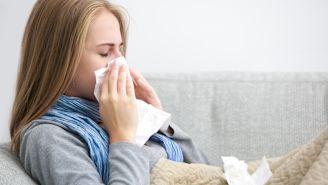4 home remedies that can help ease cold symptoms
Try easing your coughing, sneezing, and sore throat with these smart at-home solutions.

The common cold is a viral infection that can be spread by direct contact with someone who has a cold. It can also be transferred from one person to another by way of tiny air droplets released through a sneeze, cough, or by someone blowing their nose. Cold viruses can live on surfaces for several hours, too; you can become ill by touching a contaminated surface and then touching your eyes, mouth, or nose.
Typical symptoms of a cold include runny nose, nasal congestion, sneezing, sore throat, cough, and headache. Symptoms usually last for three to seven days, up to two weeks.
The good news is that keeping up on your overall hygiene, including washing your hands frequently for at least 20 seconds each time, can help prevent the spread of germs. So can wearing a medical mask over your mouth and nose, much as you would to help prevent COVID.
Although there is no proven cure for a cold, there are ways to get some relief. Here are four remedies that may help.

Use a humidifier
A humidifier won’t get rid of your cold, but if you have a stuffy nose, it might make it easier for you to breathe. It does this by helping to keep the mucous membranes in the lining of your nose moist. Try to maintain your room’s humidity somewhere between 30 and 50 percent.
Take note, however: Although a humidifier can be a useful tool to generate moisture, it can also spread germs and mold through the air if you don’t rinse and scrub it with dish soap and warm water frequently. Keeping your humidifier clean is especially important for people with allergies or asthma.
Taking a hot shower may help temporarily, too, thanks to the humidity it generates within a closed space.

Gargle with saltwater
When mucus drips into the back of your throat (also called postnasal drip), you may end up with a sore throat, but gargling with salt water may provide temporary relief. Try mixing 1/4 to 1/2 teaspoon of table salt into 4 to 8 ounces of warm water, and then gargle. While it won’t cure the underlying infection, it’s not likely to be harmful.

Drink lots of water
Although staying hydrated doesn’t reduce the duration of cold symptoms, it may ease them. Drinking plenty of water can loosen congestion in the throat and maintain your balance of bodily fluids. Maintaining proper hydration can help especially if you feel a fever coming on: Any time you’re sweating out your liquids, it’s important to replenish them. In addition to water, drinking warm beverages such as tea or soup can help relieve congestion.
Always talk to your healthcare provider (HCP) about how much water is right for you. Individual needs vary depending on your activity level, the weather, environmental conditions, and medications you may be taking.

Over-the-counter medications
Unfortunately, there’s no medication proven to cure the common cold. Sometimes, however, nasal decongestant or antihistamine medicines may help a runny nose and sneezing. Some pain relievers can ease discomfort associated with a headache or sore throat, as well, and certain cough suppressant medications could help control short-term coughing.
It’s important to find what works for you. Carefully read product labels and only take medications as directed. Speak with your HCP if you have any concerns about specific drugs. Also reach out to your HCP if your cold symptoms don’t improve or worsen after three to five days.

MedlinePlus. “Common Cold.” May 25, 2021. Accessed June 2, 2021.
UpToDate.com. “Patient education: The common cold in adults (Beyond the Basics).” May 24, 2021. Accessed June 2, 2021.
MedlinePlus. “Germs and Hygiene.” April 6, 2020. Accessed June 2, 2021.
Mayo Clinic. “Humidifiers: Air moisture eases skin, breathing symptoms.” January 14, 2021. Accessed June 2, 2021.
Mayo Clinic. “Sore Throat.” July 21, 2020. Accessed June 2, 2021.
UpToDate.com. “Patient education: Sore throat in adults (Beyond the Basics).” May 2021. Accessed June 2, 2021.
Mayo Clinic. “Cold remedies: What works, what doesn’t, what can’t hurt.” June 27, 2020. Accessed June 2, 2021.
Medscape. “How long can rhinoviruses survive on skin and inanimate surfaces?” September 11, 2020. Accessed September 15, 2021.
University of Washington Health. “The Common Cold and Your Child.” September 18, 2019. Accessed September 15, 2021.
More On


video

article

slideshow


video


video
